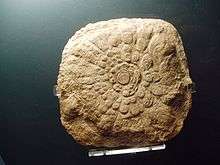Mawsonites
Mawsonites is a fossil genus dating to the Ediacaran Period from 630 – 542 million years ago during the Precambrian era. The fossils consist of a rounded diamond shape, made up from lobes radiating out from a central circle roughly 12 cm in diameter. There are about 19 radiations from the central circle.
| Mawsonites Temporal range: Ediacaran | |
|---|---|
 | |
| Fossil of Mawsonites spriggi at Natural History Museum, London | |
| Scientific classification | |
| Kingdom: | |
| Genus: | Mawsonites Glaessner & Wade 1966 |
| Species: | M. spriggi Glaessner & Wade 1966 |
The type species is Mawsonites spriggi, named after Douglas Mawson, and Reg Sprigg. It was named by Martin Glaessner and Mary Wade in 1966.[1]
Its biological affinities were called into question amidst suggestions that it might represent a mud volcano or other sedimentary structure, but further research showed that these structures could not satisfactorily account for its complexity.[2]
The fossil has been theorized to represent algae holdfasts, jellyfish (although this is considered unlikely)[3], a filter feeder, a burrow, a microbial colony or invertebrate tracks.[4] Several of these possibilities would indicate that Mawsonites represents a trace fossil, not an organism.
See also
References
- "The Late Precambrian Fossils from Ediacara, South Australia". Palaeontology. 9 (4): 599–628. 1966.
- van Loon, A.J. (2008). "The nature of Mawsonites (Ediacara fauna)". Gondwana Research. 14 (1–2): 175–182. Bibcode:2008GondR..14..175V. doi:10.1016/j.gr.2007.08.009.
- McMenamin, Mark A. S. (1990). The Emergence of Animals. New York: Columbia Press. p. 19-24. ISBN 0-231-06647-3.
- Walker, Cyril; Ward, David (2002). Fossils (Second American ed.). Dorling Kindersley. p. 43. ISBN 0-7894-8984-8.
- Digging Up Deep Time, Paul Willis and Abbie Thomas
- Ediacaran Taxa